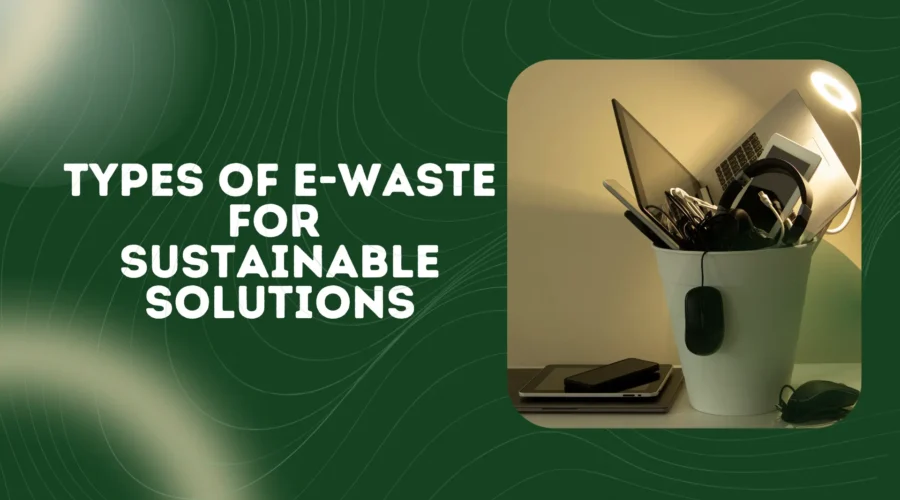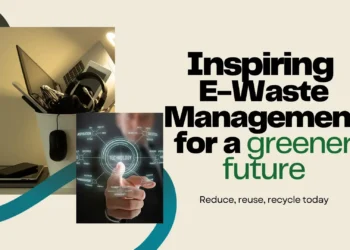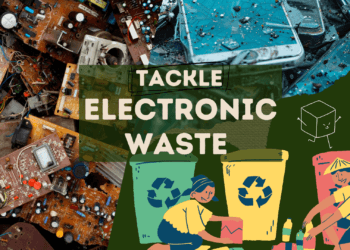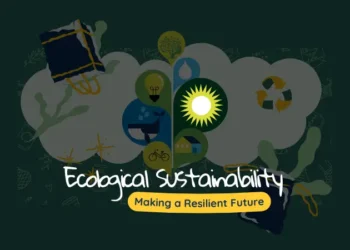We use gadgets like phones, computers, and TVs every day. But what happens when they…

The Power of Knowledge: Breaking Down Types of E-Waste for Sustainable Solutions
Have you ever thought about what happens to your old mobile phones, laptops, or broken TVs? These gadgets don’t just vanish. They turn into something called e-waste, which means electronic waste. There are many types of e-waste, like computers, phones, TVs, and even small things like batteries and chargers. Understanding the types of e-waste is really important. When we know more about e-waste, we can learn how to take care of it properly. This helps us protect our Earth and make smart decisions for a cleaner, healthier future.
What Is E-Waste?
E-waste, or electronic waste, refers to all the old or broken electronic devices that we no longer use or need. Examples include old mobile phones, computers, TVs, and even small gadgets like headphones. These types of e-waste are often thrown away and end up in landfills, where they can harm the environment. This is because e-waste contains dangerous materials like lead, mercury, and plastic. These materials take a very long time to break down and can release harmful chemicals into the air, soil, and water, making them unsafe for humans, animals, and plants. It’s important to handle different types of e-waste carefully to protect our planet, considering the government’s e-waste management rule in India.
Why Should We Care About E-Waste?
Every year, people around the world throw away millions of tons of old electronics, called e-waste. This can harm our planet by causing more pollution and wasting important materials that could be reused. But there is good news! If we learn about the types of e-waste, like old phones, computers, and TVs, we can find better ways to recycle and reuse them. We can help make the Earth cleaner and healthier by reducing e-waste. E-waste means old electronics like phones, computers, and TVs that we no longer use. Instead of throwing them away, we should handle them properly. This helps protect nature and keeps our planet safe. It’s also a good idea to learn about the different kinds of e-waste so we can take better care of them. Knowing what e-waste is and how to handle it helps us protect the environment and keep it healthy for everyone.
Different Types of E-Waste

Let’s break down the types of e-waste into simple categories to better understand what they are and how to handle them:
1. Household Electronics
This type of e-waste includes items like televisions, refrigerators, washing machines, and microwaves. For example, when a TV stops working, or you upgrade to a new fridge, the old one becomes e-waste.
- Sustainable Solution: Many household electronics can be recycled. For example, metals and plastics from refrigerators can be reused to make new products.
2. Computers and Accessories
Old laptops, desktops, keyboards, and computer mice are common examples of e-waste. These items often contain valuable materials like gold and copper.
- Real-Life Example: In some countries, people are trained to carefully dismantle computers to recover these precious materials. Recycling these parts reduces the need to mine new resources.
3. Mobile Phones and Tablets
Did you know that over 1 billion mobile phones are thrown away each year? Smartphones and tablets are another major type of e-waste. They contain hazardous materials like lead but also useful components like rare earth metals.
- Sustainable Solution: Old phones can be refurbished and donated to schools or charities. Some companies even offer trade-in programs where you can exchange your old phone for discounts on new ones.
4. Batteries
Batteries, especially phones, laptops, and cars, are a unique type of e-waste. They often contain toxic chemicals that can leak into the soil and water.
- Real-Life Example: Many stores now have collection bins for old batteries. Once collected, these batteries are safely processed to recover materials like lithium and cobalt.
5. Lighting Equipment
Old bulbs, fluorescent lamps, and LEDs are types of e-waste that often get overlooked. These items can release harmful gases if not disposed of properly.
- Sustainable Solution: Specialized recycling centres can safely handle lighting equipment and extract reusable materials.
6. Entertainment Devices
This includes items like video game consoles, speakers, and DVD players. When these gadgets break or become outdated, they are often thrown away.
- Real-Life Example: Instead of discarding your old gaming console, you could sell it to someone who enjoys retro games or donate it to a community centre.
7. Medical Devices
Old medical equipment like thermometers, blood pressure monitors, and hearing aids also fall under e-waste. These devices may contain mercury or other harmful substances.
- Sustainable Solution: Hospitals and clinics can work with recycling programs to ensure the safe disposal of medical e-waste.
Advantages of Sustainable Development
Now that we have learned about the types of e-waste let’s talk about why it’s so important to handle e-waste properly. Managing e-waste helps us protect our planet and make sure it stays healthy for future generations. This is called sustainable development. It means we use the Earth’s resources in a way that meets our needs today without ruining things for people in the future.
Taking care of e-waste has many benefits. When we recycle or reuse different types of e-waste, we help save valuable materials like metals and plastics. These materials can be used again instead of being thrown away. Recycling also helps protect our environment. This is because fewer dangerous chemicals from e-waste get into the soil, water, or air, which reduces pollution. By taking care of different types of e-waste, we can help make our planet a cleaner, greener, and safer place for all living things. E-waste includes old or broken electronics like mobile phones, computers, and TVs, which can harm the environment if not handled properly. When we manage these types of e-waste the right way, we stop harmful chemicals from polluting the soil, water, and air. It’s important to take care of nature so our planet stays healthy and beautiful for everyone to enjoy. Learning how to handle different types of e-waste is a big step toward making our world a cleaner and better place for the future.

1. Protecting the Environment
By recycling e-waste, we prevent toxic materials from polluting the Earth. For instance, properly recycling batteries ensures harmful chemicals don’t seep into the soil and water.
2. Saving Resources
Did you know we can recycle old electronics, called e-waste, to get useful materials like gold, silver, and copper? These materials can be used to make new devices, so we don’t have to dig more from the Earth. Recycling e-waste is a great way to help the planet!
3. Reducing Energy Use
Recycling is a smart way to use things we already have instead of making new ones. For example, when we recycle paper, plastic, or metal, we don’t have to spend as much energy as we would to make these materials from scratch. Making new products often means cutting down trees, digging up metal from the ground, or using lots of oil and gas. This takes a lot of energy.
But when we recycle, we reuse materials that are already made. This means factories use less power, and we help save natural resources. Recycling uses less energy than producing new materials, which is better for the Earth and helps reduce pollution. It’s an easy way to protect our planet while saving energy!
4. Creating Jobs
E-waste recycling programs create jobs for people who collect, sort, and process waste. This not only benefits the environment but also helps communities economically.
5. Raising Awareness
When we manage e-waste responsibly, we inspire others to do the same. Schools, businesses, and governments can work together to create a culture of sustainability.
What Can You Do?
Here are some simple steps you can take to handle e-waste responsibly:
- Think Before You Buy: Only buy new electronics when necessary. Choose high-quality products that last longer.
- Repair Instead of Replace: If something breaks, try to fix it instead of buying a new one.
- Recycle Properly: Look for e-waste recycling centres in your area. Many cities have drop-off points for old electronics.
- Donate: If your gadgets are still working, consider donating them to someone in need.
- Join Awareness Campaigns: Teach your family and friends about the importance of managing e-waste.
Real-Life Impact
India, has a program called E-Parishara. This program helps recycle electronic waste, or e-waste. E-waste includes things like old computers, mobile phones, and other gadgets that people don’t use anymore.
E-Parishara has done a great job by recycling thousands of tons of e-waste. Instead of throwing away old electronics, the program makes sure they are reused or safely broken down. This helps keep our environment clean and reduces pollution. In Ghana, young people are using broken electronics to make new things. This gives them jobs and helps cut down on waste. These examples show that taking care of different types of e-waste can really help the environment and make the world a better place.
Conclusion: Breaking Down Types of E-Waste for Sustainable Solutions
Knowing about types of e-waste can help us take care of our planet. E-waste includes things like old phones, broken computers, and other gadgets we don’t use anymore. If we learn to recycle, reuse, and dispose of things the right way, we can protect our planet and save important resources. This helps keep the Earth clean and healthy for everyone. Even small things, like recycling your old phone, can help a lot! When you recycle your phone, you’re doing something good for the environment. If you talk to a friend about why recycling e-waste is important, you’re helping even more people care about the planet. Let’s all work together to keep the Earth clean and green for everyone!




Comments (0)